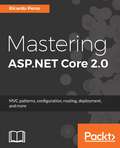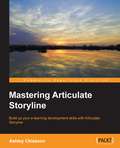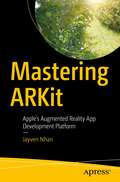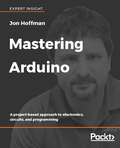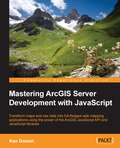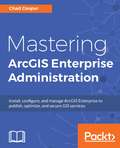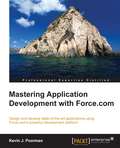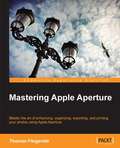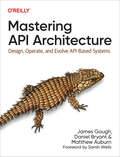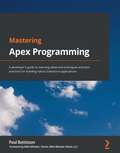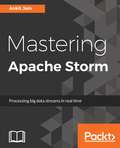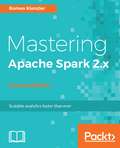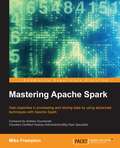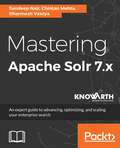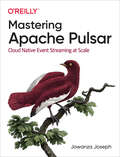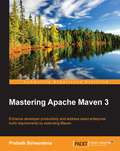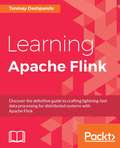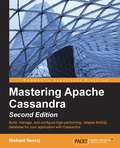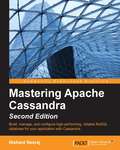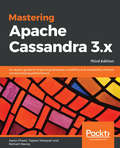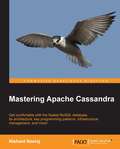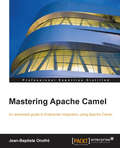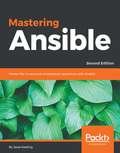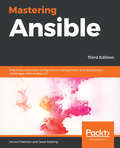- Table View
- List View
Mastering ASP.NET Core 2.0
by Ricardo PeresBecome an expert in the shiny new version of ASP.NET About This Book • Grasp the advanced concepts of MVC Core and start making professional-grade applications • Migrate from previous versions of ASP.NET MVC to ASP.NET Core • This book will take you on a journey through all the aspects of ASP.NET Core 2.0 Who This Book Is For If you are a developer who knows the basics of ASP.NET MVC and wants to build powerful applications, this book is for you. Basic C# experience and an understanding of HTML and CSS is assumed. What You Will Learn • Get to know the new features of ASP.NET Core 2.0 • Find out how to configure ASP.NET Core • Configure routes to access ASP.NET Core resources • Create controllers and action methods and see how to maintain the state • Create views to display contents • Implement and validate forms and retrieve information from them • Write reusable modules for ASP.NET Core • Deploy ASP.NET Core to other environments In Detail ASP.NET is an open source web framework that builds modern web apps and services. This book is your one-stop guide to the new features of ASP.NET Core 2.0, including web APIs and MVC. We begin with a brief overview of the basics, taking you through the MVC pattern, platforms, dependencies, and frameworks. We then move on to setting up and configuring the MVC environment before talking about routing and advanced routing options. Next, we'll look at model binding, controllers and actions, filters, user authentication, and testing. Moving on, you'll learn about all the aspects of syntax and processes when working with Razor. You'll be introduced to client-side development and will get to know about the security aspects of ASP.NET Core. We will also look at microservices with ASP.NET Core. Finally, you'll find out how to deploy ASP.NET Core to new environments such as Azure, AWS, and Docker. By the end of the book, you will be well versed with development in ASP.NET Core and will have a deep understanding of how to interact with the framework and work cross-platform. Style and approach Find out how to design modern, cross-platform, business oriented web applications that serve the client needs in the age of emerging .NET framework
Mastering Articulate Storyline
by Ashley ChiassonBuild up your e-learning development skills with Articulate Storyline About This Book * Develop interactive e-learning projects using advanced techniques * Impress your clients and/or audience with out-of-the-box interactions * Step-by-step walkthroughs provide practical solutions Who This Book Is For This book is for anyone experienced in using the basic functions of Articulate Storyline who are yearning to learn more. It's designed to provide a brief overview of key concepts, to help you refresh your knowledge of common functions, and teach you how to push Storyline to the limit! What You Will Learn * Familiarize yourself with best practices for e-learning development * Review key Storyline concepts before diving in deep with development * Discover new ways of working within Storyline to extend slide content and enhance interactivity * Personalize your story with advanced variable-based interactions * See how JavaScript can be used in your stories to do some really neat things * Assess your learners using customized assessment options and find out how to troubleshoot common issues * Customize the learning experience by modifying the player properties and publishing settings * Customize your story and prepare it for publishing In Detail Storyline is a powerful e-learning authoring tool that allows you to take your creativity to the next level. However, more often than not, projects don't require such complex interactions, leaving Storyline's full capabilities untapped. This book will provide you with the information you need to take your Storyline development up a notch by leveraging the full suite of possibilities Storyline has to offer. You will be provided with a refresher of the key concepts before we take you deep into the exciting world of enhanced interactivity, variables, and even some JavaScript--oh my! With downloadable activities, you can either follow along and compare your output, use the activities as they are, modify the activities to suit your own needs, or reverse-engineer the activities to better understand how they were developed. Style and approach You'll get hands-on working with project files that were created with you in mind. As you move through each chapters, the practical, step-by-step approach will get you using some of the more advanced features of Storyline to create polished and snazzy interactions.
Mastering ARKit: Apple’s Augmented Reality App Development Platform
by Jayven NhanEmbark on a journey to build an augmented reality world. This book puts theory into practical application by building unique augmented reality apps specific to each chapter’s topic.You’ll learn to engineer successful, well-designed, and comprehensive augmented reality applications for Apple devices. First, uncover the foundation of augmented reality on Apple platforms. Understand the building blocks and inner workings of the technologies that power augmented reality. Then, learn about building AR apps using ARKit, SceneKit, SpriteKit, RealityKit, and RealityComposer. You’ll study augmented reality app business models, designs, and content for the ultimate user experience. Plus, you’ll cover the theories and practicalities of ARKit APIs such as surface detection, working with world maps, body motion capture, face tracking, object scanning and detecting, people occlusion, and more. Chapter by chapter, this book helps you to become an advanced augmented reality engineer. By the end of the book, you’ll have the necessary mental models and tools to engineer delightful experiences in Apple’s augmented reality platforms. What You'll LearnBuild AR apps with SceneKit, SpriteKit, RealityKit, and RealityComposerUnderstand the business models that support augmented realityIncorporate surface detection, computer vision, and body motion capture in your appsWho This Book Is ForiOS developers who want to expand their knowledge of ARKit. They should have a solid foundation in the Swift programming language and understand the basics of navigating Xcode.
Mastering Arduino: A project-based approach to electronics, circuits, and programming
by Jon HoffmanMastering Arduino is a practical, no-nonsense guide that will teach you the electronics and programming skills that you need to create advanced Arduino projects.Key FeaturesCovers enough electronics and code for users at any levelIncludes complete circuit diagrams for all projectsFinal robot project combines knowledge from all the chaptersBook DescriptionMastering Arduino is an all-in-one guide to getting the most out of your Arduino. This practical, no-nonsense guide teaches you all of the electronics and programming skills that you need to create advanced Arduino projects. This book is packed full of real-world projects for you to practice on, bringing all of the knowledge in the book together and giving you the skills to build your own robot from the examples in this book. The final two chapters discuss wireless technologies and how they can be used in your projects. The book begins with the basics of electronics, making sure that you understand components, circuits, and prototyping before moving on. It then performs the same function for code, getting you into the Arduino IDE and showing you how to connect the Arduino to a computer and run simple projects on your Arduino.Once the basics are out of the way, the next 10 chapters of the book focus on small projects centered around particular components, such as LCD displays, stepper motors, or voice synthesizers. Each of these chapters will get you familiar with the technology involved, how to build with it, how to program it, and how it can be used in your own projects. What you will learnExplains the basics of electronics and circuits along with the Arduino IDE and basic C operationsUse sensors to build a mini weather stationControl LEDs using codePower a robot arm using stepper motorsRemotely control your Arduino using RF, Bluetooth LE, and Bluetooth ClassicMake a sound tone generator with buttonsWho this book is forMastering Arduino is for anybody who wants to experiment with an Arduino board and build simple projects. No prior knowledge is required, as the fundamentals of electronics and coding are covered in this book as well as advance projects.
Mastering ArcGIS Server Development with JavaScript
by Ken DomanTransform maps and raw data into full-fledged web mapping applications using the power of the ArcGIS JavaScript API and JavaScript libraries About This Book * Create and share modern map applications for desktops, tablets, and mobile browsers * Present and edit geographic and related data through maps, charts, graphs, and more * Learn the tools, tips, and tricks made available through the API and related libraries with examples of real-world applications Who This Book Is For This book is intended for intermediate developers who want to design web mapping applications. You should have some experience with geographic information systems, especially with ArcGIS products such as ArcGIS Server. It also helps to have some experience with HTML, CSS, and JavaScript. What You Will Learn * Create single-page mapping applications, lining up data from different sources * Search for and display geographic and tabular information based on locations and attributes * Customize maps and widgets to deliver the best user experience * Present location data intuitively using charts and graphs * Integrate mapping applications with your favorite JavaScript frameworks * Test the working of your web map application and take advantage of cloud services such as ArcGIS Online * Create modern-looking web maps through styling tips and tricks In Detail ESRI and its ArcGIS line of software have been an industry leader in digital map production and publication for over 30 years. ArcGIS Server lets you design, configure, and publish maps that can be viewed and edited through the Internet. After designing basic maps, you may want to find out new and innovative ways to represent information using these maps. In this book, you'll work through practical examples, experiencing the pitfalls and successes of creating desktop and mobile map applications for a web browser using the ArcGIS Server platform. The book begins by introducing you to ArcGIS Server and ESRI's JavaScript API. You'll work with your first web map and then move on to learn about ESRI's building blocks. A Dojo AMS style widget will help you create your own widgets for a map and then see how to collect geographic data. Furthermore, you will learn different techniques such as using Dojo Charts to create charts and graphs to represent your data. Then you will see how to use ESRI JavaScript API with other JavaScript libraries and different styling methods to make your map stand out. By the end of the book, you will discover how to make your application compatible with different devices and platforms and test it using testing libraries. Style and approach An in-depth guide that explores web application development using ArcGIS Server and the ArcGIS JavaScript API. Topics are explained in the context of developing two applications for fictional clients. Details of application development, including possible pitfalls and best practices, are included in this book.
Mastering ArcGIS Enterprise Administration
by Chad CooperLearn how to confidently install, configure, secure, and fully utilize your ArcGIS Enterprise system. About This Book • Install and configure the components of ArcGIS Enterprise to meet your organization's requirements • Administer all aspects of ArcGIS Enterprise through user interfaces and APIs • Optimize and Secure ArcGIS Enterprise to make it run efficiently and effectively Who This Book Is For This book will be geared toward senior GIS analysts, GIS managers, GIS administrators, DBAs, GIS architects, and GIS engineers that need to install, configure, and administer ArcGIS Enterprise 10.5.1. What You Will Learn • Effectively install and configure ArcGIS Enterprise, including the Enterprise geodatabase, ArcGIS Server, and Portal for ArcGIS • Incorporate different methodologies to manage and publish services • Utilize the security methods available in ArcGIS Enterprise • Use Python and Python libraries from Esri to automate administrative tasks • Identify the common pitfalls and errors to get your system back up and running quickly from an outage In Detail ArcGIS Enterprise, the next evolution of the ArcGIS Server product line, is a full-featured mapping and analytics platform. It includes a powerful GIS web services server and a dedicated Web GIS infrastructure for organizing and sharing your work. You will learn how to first install ArcGIS Enterprise to then plan, design, and finally publish and consume GIS services. You will install and configure an Enterprise geodatabase and learn how to administer ArcGIS Server, Portal, and Data Store through user interfaces, the REST API, and Python scripts. This book starts off by explaining how ArcGIS Enterprise 10.5.1 is different from earlier versions of ArcGIS Server and covers the installation of all the components required for ArcGIS Enterprise. We then move on to geodatabase administration and content publication, where you will learn how to use ArcGIS Server Manager to view the server logs, stop and start services, publish services, define users and roles for security, and perform other administrative tasks. You will also learn how to apply security mechanisms on ArcGIS Enterprise and safely expose services to the public in a secure manner. Finally, you'll use the RESTful administrator API to automate server management tasks using the Python scripting language. You'll learn all the best practices and troubleshooting methods to streamline the management of all the interconnected parts of ArcGIS Enterprise. Style and approach The book takes a pragmatic approach, starting with installation & configuration of ArcGIS Enterprise to finally building a robust GIS web infrastructure for your organization.
Mastering Application Development with Force.com
by Kevin J. PoormanDesign and develop state-of-the-art applications using Force.com's powerful development platform About This Book * Flaunt your skillsets by developing complex applications that include demanding concepts such as triggers, Visualforce controllers, batch jobs, and Lightning components * Earn the gratitude of your colleagues by structuring a project so that multiple developers can work independently of each other * Kevin Poorman, the author of the book and a Force.com MVP, shares his years of Force.com knowledge and experience with you through the medium of telling examples Who This Book Is For If you're a Force.com developer with a fundamental understanding of Apex and JavaScript but now want to enhance your skills with tips, tricks, and guidance on the best architectural and engineering practices, then this book is for you. What You Will Learn * Creating triggers, and the best practices for writing them * Developing a number of Visualforce controllers and extensions * Integrating third-party web APIs into your Apex code * Writing unit tests that cover testing bulk safety, user and profile settings, and negative tests * Creating a Lightning component for use in Salesforce1 * Getting acquainted with various methods for deploying metadata between orgs * Using the Rest sObject API for access to Salesforce objects and data using the REST methodology * Learning about overarching architectural considerations such as naming conventions, testing practices, and data modeling practices In Detail Force.com is an extremely powerful, scalable, and secure cloud platform, delivering a complete technology stack, ranging from databases and security to workflow and the user interface. With salesforce.com's Force.com cloud platform, you can build any business application and run it on your servers. The book will help you enhance your skillset and develop complex applications using Force.com. It gets you started with a quick refresher of Force.com's development tools and methodologies, and moves to an in-depth discussion of triggers, bulkification, DML order of operations, and trigger frameworks. Next, you will learn to use batchable and schedulable interfaces to process massive amounts of information asynchronously. You will also be introduced to Salesforce Lightning and cover components--including backend (apex) controllers, frontend (JavaScript) controllers, events, and attributes--in detail. Moving on, the book will focus on testing various apex components: what to test, when to write the tests, and--most importantly--how to test. Next, you will develop a changeset and use it to migrate your code from one org to another, and learn what other tools are out there for deploying metadata. You will also use command-line tools to authenticate and access the Force.com Rest sObject API and the Bulk sObject API; additionally, you will write a custom Rest endpoint, and learn how to structure a project so that multiple developers can work independently of each other without causing metadata conflicts. Finally, you will take an in-depth look at the overarching best practices for architecture (structure) and engineering (code) applications on the Force.com platform. Style and approach A step-by-step tutorial, with plenty of tips and tricks that will help you develop complex Force.com applications.
Mastering Apple HomePod: The Ultimate HomePod Gebruikershandleiding IOS 12
by Adidas WilsonHet nieuwe apparaat, HomePod, biedt een gemakkelijke en verbazingwekkende manier voor Apple-gebruikers om te genieten van AirPlay, Apple Music en hun HomeKit-apparaten vanaf elke locatie te bedienen. HomePod is niet gemaakt om een concurrent van Google Home of Amazon Echo te zijn, net zoals de MacBook Air niet was ontworpen om te concurreren met de netbook. Natuurlijk delen ze een aantal kenmerken. De HomePod slimme luidspreker kan bijvoorbeeld spraakgestuurd worden gebruikt en de MacBook Air is compact en lichtgewicht. HomePod is echter slechts een huishoudhulp voor $ 350; net als de MacBook was een laptopcomputer van $ 200. De Fire Phone van Amazon was niet echt een hit. Alexa moest daarom veel verkopen, zodat Prime in meer mensenlevens kon blijven. Dit was een succes, dankzij de prijsbewuste Echo. Google, aan de andere kant, heeft een briljante beslissing genomen om in hun voetsporen te treden omdat het zijn onverzadigbare data dorst moest stillen. Wat HomePod betreft, was iets een beetje anders. De AirPod is ontworpen om u onderweg van uw favoriete muziek te laten genieten terwijl HomePod werd ontworpen om u op uw gemak bij het luisteren naar uw favoriete muziek thuis te laten genieten. AirPods miste draden en voldoende oppervlakte voor traditionele knoppen. Daarom was de Siri-stembesturing de enige manier om met de gadget om te gaan, je moet in de buurt van het apparaat zijn.
Mastering Apple Aperture
by Thomas FitzgeraldWritten in a conversational style, the author will share his knowledge on advanced Aperture topics with detailed discussions of advanced topics, the theory behind some of those topics and lots of hints and tips for ways to improve your workflow.Photographer's who have a basic understanding of Aperture
Mastering API Architecture
by James Gough Daniel Bryant Matthew AuburnMost organizations with a web presence build and operate APIs; the doorway for customers to interact with the company's services. Designing, building, and managing these critical programs affect everyone in the organization, from engineers and product owners to C-suite executives. But the real challenge for developers and solution architects is creating an API platform from the ground up.With this practical book, you'll learn strategies for building and testing REST APIs that use API gateways to combine offerings at the microservice level. Authors James Gough, Daniel Bryant, and Matthew Auburn demonstrate how simple additions to this infrastructure can help engineers and organizations migrate to the cloud; and open the opportunity to connect internal services using technologies like a service mesh.Learn API fundamentals and architectural patterns for building an API platformUse practical examples to understand how to design, build, and test API-based systemsDeploy, operate, and configure key components of an API platformUse API gateways and service meshes appropriately, based on case studiesUnderstand core security and common vulnerabilities in API architectureSecure data and APIs using threat modeling and technologies like OAuth2 and TLSLearn how to evolve existing systems toward API- and cloud-based architectures
Mastering Apex Programming: A developer's guide to learning advanced techniques and best practices for building robust Salesforce applications
by Paul BattissonThis book is for Salesforce developers who are interested in mastering Apex programming skills. You’ll also find this book helpful if you’re an experienced Java or C# developer looking to switch to Apex programming for developing apps on the Salesforce platform. Basic Apex programming knowledge will assist with understanding the concepts covered.
Mastering Apache Storm
by Ankit JainMaster the intricacies of Apache Storm and develop real-time stream processing applications with ease About This Book • Exploit the various real-time processing functionalities offered by Apache Storm such as parallelism, data partitioning, and more • Integrate Storm with other Big Data technologies like Hadoop, HBase, and Apache Kafka • An easy-to-understand guide to effortlessly create distributed applications with Storm Who This Book Is For If you are a Java developer who wants to enter into the world of real-time stream processing applications using Apache Storm, then this book is for you. No previous experience in Storm is required as this book starts from the basics. After finishing this book, you will be able to develop not-so-complex Storm applications. What You Will Learn • Understand the core concepts of Apache Storm and real-time processing • Follow the steps to deploy multiple nodes of Storm Cluster • Create Trident topologies to support various message-processing semantics • Make your cluster sharing effective using Storm scheduling • Integrate Apache Storm with other Big Data technologies such as Hadoop, HBase, Kafka, and more • Monitor the health of your Storm cluster In Detail Apache Storm is a real-time Big Data processing framework that processes large amounts of data reliably, guaranteeing that every message will be processed. Storm allows you to scale your data as it grows, making it an excellent platform to solve your big data problems. This extensive guide will help you understand right from the basics to the advanced topics of Storm. The book begins with a detailed introduction to real-time processing and where Storm fits in to solve these problems. You'll get an understanding of deploying Storm on clusters by writing a basic Storm Hello World example. Next we'll introduce you to Trident and you'll get a clear understanding of how you can develop and deploy a trident topology. We cover topics such as monitoring, Storm Parallelism, scheduler and log processing, in a very easy to understand manner. You will also learn how to integrate Storm with other well-known Big Data technologies such as HBase, Redis, Kafka, and Hadoop to realize the full potential of Storm. With real-world examples and clear explanations, this book will ensure you will have a thorough mastery of Apache Storm. You will be able to use this knowledge to develop efficient, distributed real-time applications to cater to your business needs. Style and approach This easy-to-follow guide is full of examples and real-world applications to help you get an in-depth understanding of Apache Storm. This book covers the basics thoroughly and also delves into the intermediate and slightly advanced concepts of application development with Apache Storm.
Mastering Apache Spark 2.x - Second Edition
by Romeo KienzlerAdvanced analytics on your Big Data with latest Apache Spark 2.x About This Book • An advanced guide with a combination of instructions and practical examples to extend the most up-to date Spark functionalities. • Extend your data processing capabilities to process huge chunk of data in minimum time using advanced concepts in Spark. • Master the art of real-time processing with the help of Apache Spark 2.x Who This Book Is For If you are a developer with some experience with Spark and want to strengthen your knowledge of how to get around in the world of Spark, then this book is ideal for you. Basic knowledge of Linux, Hadoop and Spark is assumed. Reasonable knowledge of Scala is expected. What You Will Learn • Examine Advanced Machine Learning and DeepLearning with MLlib, SparkML, SystemML, H2O and DeepLearning4J • Study highly optimised unified batch and real-time data processing using SparkSQL and Structured Streaming • Evaluate large-scale Graph Processing and Analysis using GraphX and GraphFrames • Apply Apache Spark in Elastic deployments using Jupyter and Zeppelin Notebooks, Docker, Kubernetes and the IBM Cloud • Understand internal details of cost based optimizers used in Catalyst, SystemML and GraphFrames • Learn how specific parameter settings affect overall performance of an Apache Spark cluster • Leverage Scala, R and python for your data science projects In Detail Apache Spark is an in-memory cluster-based parallel processing system that provides a wide range of functionalities such as graph processing, machine learning, stream processing, and SQL. This book aims to take your knowledge of Spark to the next level by teaching you how to expand Spark's functionality and implement your data flows and machine/deep learning programs on top of the platform. The book commences with an overview of the Spark ecosystem. It will introduce you to Project Tungsten and Catalyst, two of the major advancements of Apache Spark 2.x. You will understand how memory management and binary processing, cache-aware computation, and code generation are used to speed things up dramatically. The book extends to show how to incorporate H20, SystemML, and Deeplearning4j for machine learning, and Jupyter Notebooks and Kubernetes/Docker for cloud-based Spark. During the course of the book, you will learn about the latest enhancements to Apache Spark 2.x, such as interactive querying of live data and unifying DataFrames and Datasets. You will also learn about the updates on the APIs and how DataFrames and Datasets affect SQL, machine learning, graph processing, and streaming. You will learn to use Spark as a big data operating system, understand how to implement advanced analytics on the new APIs, and explore how easy it is to use Spark in day-to-day tasks. Style and approach This book is an extensive guide to Apache Spark modules and tools and shows how Spark's functionality can be extended for real-time processing and storage with worked examples.
Mastering Apache Spark
by Mike FramptonGain expertise in processing and storing data by using advanced techniques with Apache Spark About This Book * Explore the integration of Apache Spark with third party applications such as H20, Databricks and Titan * Evaluate how Cassandra and Hbase can be used for storage * An advanced guide with a combination of instructions and practical examples to extend the most up-to date Spark functionalities Who This Book Is For If you are a developer with some experience with Spark and want to strengthen your knowledge of how to get around in the world of Spark, then this book is ideal for you. Basic knowledge of Linux, Hadoop and Spark is assumed. Reasonable knowledge of Scala is expected. What You Will Learn * Extend the tools available for processing and storage * Examine clustering and classification using MLlib * Discover Spark stream processing via Flume, HDFS * Create a schema in Spark SQL, and learn how a Spark schema can be populated with data * Study Spark based graph processing using Spark GraphX * Combine Spark with H20 and deep learning and learn why it is useful * Evaluate how graph storage works with Apache Spark, Titan, HBase and Cassandra * Use Apache Spark in the cloud with Databricks and AWS In Detail Apache Spark is an in-memory cluster based parallel processing system that provides a wide range of functionality like graph processing, machine learning, stream processing and SQL. It operates at unprecedented speeds, is easy to use and offers a rich set of data transformations. This book aims to take your limited knowledge of Spark to the next level by teaching you how to expand Spark functionality. The book commences with an overview of the Spark eco-system. You will learn how to use MLlib to create a fully working neural net for handwriting recognition. You will then discover how stream processing can be tuned for optimal performance and to ensure parallel processing. The book extends to show how to incorporate H20 for machine learning, Titan for graph based storage, Databricks for cloud-based Spark. Intermediate Scala based code examples are provided for Apache Spark module processing in a CentOS Linux and Databricks cloud environment. Style and approach This book is an extensive guide to Apache Spark modules and tools and shows how Spark's functionality can be extended for real-time processing and storage with worked examples.
Mastering Apache Solr 7.x: An expert guide to advancing, optimizing, and scaling your enterprise search
by Dharmesh Vasoya Chintan Mehta Sandeep NairAccelerate your enterprise search engine and bring relevancy in your search analytics Key Features A practical guide in building expertise with Indexing, Faceting, Clustering and Pagination Master the management and administration of Enterprise Search Applications and services seamlessly Handle multiple data inputs such as JSON, xml, pdf, doc, xls,ppt, csv and much more. Book Description Apache Solr is the only standalone enterprise search server with a REST-like application interface. providing highly scalable, distributed search and index replication for many of the world's largest internet sites. To begin with, you would be introduced to how you perform full text search, multiple filter search, perform dynamic clustering and so on helping you to brush up the basics of Apache Solr. You will also explore the new features and advanced options released in Apache Solr 7.x which will get you numerous performance aspects and making data investigation simpler, easier and powerful. You will learn to build complex queries, extensive filters and how are they compiled in your system to bring relevance in your search tools. You will learn to carry out Solr scoring, elements affecting the document score and how you can optimize or tune the score for the application at hand. You will learn to extract features of documents, writing complex queries in re-ranking the documents. You will also learn advanced options helping you to know what content is indexed and how the extracted content is indexed. Throughout the book, you would go through complex problems with solutions along with varied approaches to tackle your business needs. By the end of this book, you will gain advanced proficiency to build out-of-box smart search solutions for your enterprise demands. What you will learn Design schema using schema API to access data in the database Advance querying and fine-tuning techniques for better performance Get to grips with indexing using Client API Set up a fault tolerant and highly available server with newer distributed capabilities, SolrCloud Explore Apache Tika to upload data with Solr Cell Understand different data operations that can be done while indexing Master advanced querying through Velocity Search UI, faceting and Query Re-ranking, pagination and spatial search Learn to use JavaScript, Python, SolrJ and Ruby for interacting with Solr Who this book is for The book would rightly appeal to developers, software engineers, data engineers and database architects who are building or seeking to build enterprise-wide effective search engines for business intelligence. Prior experience of Apache Solr or Java programming is must to take the best of this book.
Mastering Apache Pulsar: Cloud Native Event Streaming At Scale
by Jowanza JosephEvery enterprise application creates data, including log messages, metrics, user activity, and outgoing messages. Learning how to move these items is almost as important as the data itself. If you're an application architect, developer, or production engineer new to Apache Pulsar, this practical guide shows you how to use this open source event streaming platform to handle real-time data feeds.Jowanza Joseph, staff software engineer at Finicity, explains how to deploy production Pulsar clusters, write reliable event streaming applications, and build scalable real-time data pipelines with this platform. Through detailed examples, you'll learn Pulsar's design principles, reliability guarantees, key APIs, and architecture details, including the replication protocol, the load manager, and the storage layer.This book helps you:Understand how event streaming fits in the big data ecosystemExplore Pulsar producers, consumers, and readers for writing and reading eventsBuild scalable data pipelines by connecting Pulsar with external systemsSimplify event-streaming application building with Pulsar FunctionsManage Pulsar to perform monitoring, tuning, and maintenance tasksUse Pulsar's operational measurements to secure a production clusterProcess event streams using Flink and query event streams using Presto
Mastering Apache Maven 3
by Prabath SiriwardenaIf you are working with Java or Java EE projects and you want to take full advantage of Maven in designing, executing, and maintaining your build system for optimal developer productivity, then this book is ideal for you. You should be well versed with Maven and its basic functionality if you wish to get the most out of the book.
Mastering Apache Flink
by Tanmay DeshpandeBig data developers who are looking to process batch and real-time data on distributed systems. Basic knowledge of Hadoop and big data is assumed. Reasonable knowledge of Java or Scala is expected.
Mastering Apache Cassandra - Second Edition
by Nishant NeerajThe book is aimed at intermediate developers with an understanding of core database concepts who want to become a master at implementing Cassandra for their application.
Mastering Apache Cassandra Second Edition
by Nishant Neeraj<P><P>Build, manage, and configure high-performing, reliable NoSQL database for your application with Cassandra <P><P>About This Book <P><P>Develop applications for modelling data with Cassandra 2 <P><P>Manage large amounts of structured, semi-structured, and unstructured data with Cassandra <P><P>Explore a wide-range of Cassandra components and how they interact to create a robust, distributed system. <P><P>Who This Book Is For <P><P>The book is aimed at intermediate developers with an understanding of core database concepts who want to become a master at implementing Cassandra for their application. <P><P>What You Will Learn <P><P>Write programs using Cassandra's features more efficiently <P><P>Get the most out of a given infrastructure, improve performance, and tweak JVM <P><P>Use CQL3 in your application, which makes working with Cassandra more simple <P><P>Configure Cassandra and fine-tune its parameters depending on your needs <P><P>Set up a cluster and learn how to scale it <P><P>Monitor Cassandra cluster in different ways <P><P>Use Hadoop and other big data processing tools with Cassandra <P><P>In Detail <P><P>With ever increasing rates of data creation comes the demand to store data as fast and reliably as possible, a demand met by modern databases such as Cassandra. Apache Cassandra is the perfect choice for building fault tolerant and scalable databases. Through this practical guide, you will program pragmatically and understand completely the power of Cassandra. Starting with a brief recap of the basics to get everyone up and running, you will move on to deploy and monitor a production setup, dive under the hood, and optimize and integrate it with other software. <P><P>You will explore the integration and interaction of Cassandra components, and explore great new features such as CQL3, vnodes, lightweight transactions, and triggers. Finally, by learning Hadoop and Pig, you will be able to analyze your big data.
Mastering Apache Cassandra 3.x: An expert guide to improving database scalability and availability without compromising performance, 3rd Edition
by Nishant Neeraj Aaron Ploetz Tejaswi MalepatiBuild, manage, and configure high-performing, reliable NoSQL database for your applications with CassandraKey FeaturesWrite programs more efficiently using Cassandra's features with the help of examplesConfigure Cassandra and fine-tune its parameters depending on your needsIntegrate Cassandra database with Apache Spark and build strong data analytics pipelineBook DescriptionWith ever-increasing rates of data creation, the demand for storing data fast and reliably becomes a need. Apache Cassandra is the perfect choice for building fault-tolerant and scalable databases. Mastering Apache Cassandra 3.x teaches you how to build and architect your clusters, configure and work with your nodes, and program in a high-throughput environment, helping you understand the power of Cassandra as per the new features.Once you’ve covered a brief recap of the basics, you’ll move on to deploying and monitoring a production setup and optimizing and integrating it with other software. You’ll work with the advanced features of CQL and the new storage engine in order to understand how they function on the server-side. You’ll explore the integration and interaction of Cassandra components, followed by discovering features such as token allocation algorithm, CQL3, vnodes, lightweight transactions, and data modelling in detail. Last but not least you will get to grips with Apache Spark.By the end of this book, you’ll be able to analyse big data, and build and manage high-performance databases for your application.What you will learnWrite programs more efficiently using Cassandra's features more efficientlyExploit the given infrastructure, improve performance, and tweak the Java Virtual Machine (JVM)Use CQL3 in your application in order to simplify working with CassandraConfigure Cassandra and fine-tune its parameters depending on your needsSet up a cluster and learn how to scale itMonitor a Cassandra cluster in different waysUse Apache Spark and other big data processing toolsWho this book is forMastering Apache Cassandra 3.x is for you if you are a big data administrator, database administrator, architect, or developer who wants to build a high-performing, scalable, and fault-tolerant database. Prior knowledge of core concepts of databases is required.
Mastering Apache Cassandra
by Nishant NeerajMastering Apache Cassandra is a practical, hands-on guide with step-by-step instructions. The smooth and easy tutorial approach focuses on showing people how to utilize Cassandra to its full potential.This book is aimed at intermediate Cassandra users. It is best suited for startups where developers have to wear multiple hats: programmer, DevOps, release manager, convincing clients, and handling failures. No prior knowledge of Cassandra is required.
Mastering Apache Camel
by Jean-Baptiste OnofréThis book is intended for all Camel users who want to get the best out of Camel, and who want to implement the most efficient integration logic using best practices.
Mastering Ansible - Second Edition
by Jesse KeatingMaster the ins and outs of advanced operations with Ansible About This Book • Learn how to extend Ansible with custom modules, plugins, and inventory sources • Utilize advanced Ansible features to orchestrate rolling updates with little to no service disruptions • An up-to-date book that brings to light the newly added features in Ansible 2.x Who This Book Is For This book is for Ansible developers and operators who have an understanding of the core elements and applications but are now looking to enhance their skills in applying automation using Ansible. What You Will Learn • Gain an in-depth understanding of how Ansible works under the covers • Fully automate the Ansible playbook executions with encrypted data • Access and manipulate variable data within playbooks • Use Blocks to construct failure recovery or cleanup • Explore the Playbook debugger and Ansible Console • Troubleshoot unexpected behavior effectively • Work with cloud infrastructure providers and container systems • Develop custom modules, plugins, and dynamic inventory sources In Detail This book provides you with the knowledge you need to understand how Ansible 2.1 works at a fundamental level and leverage its advanced capabilities. You'll learn how to encrypt Ansible content at rest and decrypt data at runtime. You will master the advanced features and capabilities required to tackle the complex automation challenges of today and beyond. You will gain detailed knowledge of Ansible workflows, explore use cases for advanced features, craft well thought out orchestrations, troubleshoot unexpected behaviour, and extend Ansible through customizations. Finally, you will discover the methods used to examine and debug Ansible operations, helping you to understand and resolve issues. By the end of the book, the readers will be able to unlock the true power of the Ansible automation engine and will tackle complex real world actions with ease. Style and approach This clear, practical guide illustrates the advanced functionalities of Ansible, its system architecture, and design aspects that will help you to master Ansible with ease.
Mastering Ansible: Effectively automate configuration management and deployment challenges with Ansible 2.7, 3rd Edition
by James Freeman Jesse KeatingDesign, develop, and solve real-world automation and orchestration problems by unlocking the automation capabilities of Ansible. Key Features Tackle complex automation challenges with the newly added features in Ansible 2.7 Book Description Automation is essential for success in the modern world of DevOps. Ansible provides a simple, yet powerful, automation engine for tackling complex automation challenges. This book will take you on a journey that will help you exploit the latest version's advanced features to help you increase efficiency and accomplish complex orchestrations. This book will help you understand how Ansible 2.7 works at a fundamental level and will also teach you to leverage its advanced capabilities. Throughout this book, you will learn how to encrypt Ansible content at rest and decrypt data at runtime. Next, this book will act as an ideal resource to help you master the advanced features and capabilities required to tackle complex automation challenges. Later, it will walk you through workflows, use cases, orchestrations, troubleshooting, and Ansible extensions. Lastly, you will examine and debug Ansible operations, helping you to understand and resolve issues. By the end of the book, you will be able to unlock the true power of the Ansible automation engine and tackle complex, real- world actions with ease. What you will learn Gain an in-depth understanding of how Ansible works under the hood Fully automate Ansible playbook executions with encrypted data Access and manipulate variable data within playbooks Use blocks to perform failure recovery or cleanup Explore the Playbook debugger and the Ansible Console Troubleshoot unexpected behavior effectively Work with cloud infrastructure providers and container systems Develop custom modules, plugins, and dynamic inventory sources Who this book is for This book is for Ansible developers and operators who have an understanding of its core elements and applications but are now looking to enhance their skills in applying automation using Ansible.
